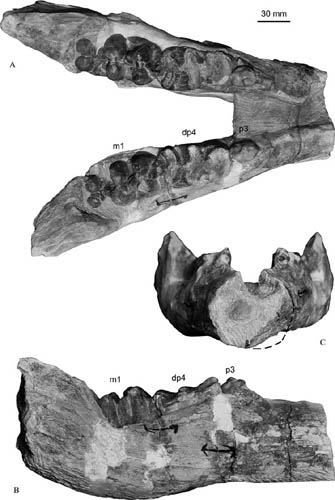| Location: Home > Research > Research Progress |
| New Material of Gomphotheres Found From Wushan County, Gansu Province of China |
|
During recent field work in the northwestern China, Dr. WANG Shiqi, Institute of Vertebrate Paleontology and Paleoanthropology (IVPP), Chinese Academy of Sciences, and his collaborators discovered a juvenile gomphotheriid mandible in the Neogene strata of the Nanyucun Locality, Wushan County, Gansu Province. Researchers assigned the specimen to Gomphotherium wimani, an extinct gomphothere of proboscidean, as reported in the latest issue of Vertebrata PalAsiatica 2013 (1). The finding provides new data on the morphology of the genus. Gomphotherium represents a critical intermediate taxon between the ancestral Phiomia and derived elephantoids in the context of proboscidean evolution. It first appeared in Chilga, Ethiopia, eastern Africa during the Late Oligocene, entered Eurasia by the Early Miocene, and reached North America by the Middle Miocene. During the Early-Middle Miocene, Gomphotherium was widespread throughout Africa and Eurasia, and the genus survived until the Late Miocene in America. Because of its broad distribution and rapid evolution, Gomphotherium is usually considered an index fossil for terrestrial stratigraphic correlations. The specimen has a deeply weathered surface, but both the left and right p3, dp4, and m1 are completely preserved. Therefore, the most important morphological features of the specimen are clear. The lower p3 is rarely preserved in gomphotheres, and it has not been recovered in any Middle Miocene platybelodont or Early-Middle Miocene choerolophodont. The cheek teeth show characters that are derived within the genus Gomphotherium, such as anteroposterior compression of lophids associated with wide interlophids, presence of weak posttrite central conules, multiplication of mesoconelets and central conules, and weak cementation. These features are consistent with the diagnosis of G. wimani. G. wimani was originally discovered in the Middle Miocene of gansu, and the fossiliferous horizon within the Nanyucun exposures that yielded G. wimani can be correlated with strata at neighboring Middle Miocene localities. Therefore, the G. wimani horizon at Nanyucun should be dated to the Middle Miocene. In combination with palynological data, the discovery of G. wimani at the Nanyucun Locality implies that the paleoenvironment of the Tianshui area in the Middle Miocene was probably relatively warm and humid, suitable for large populations of brachyodont mammals such as gomphotheres. This work was supported by the National Natural Science Foundation of China, the National Key Basic Research Program of China, and the Major Project Foundation of IVPP, CAS.  Fig.1 Mandible of Gomphotherium wimani in dorsal view (A), lateral view(B) and proximal view (C). (Image by WANG Shiqi) |